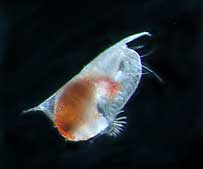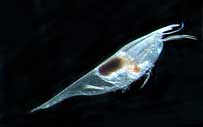 |
|||||||||
skip to content |
|||||||||
Zooplankton Defined
After NOAA supported a Census of Marine Life program to measure zooplankton in the Sargasso Sea, I wondered if people on the street had any idea what plankton was. So I asked them.
"Plankton," said one man hand on chin. "I don't really know, but it sounds like it might be a planet."
"Is it a disease?," a woman asked, looking for an up-and-down head nod.
"It's a city," declared another woman with authority, "...maybe in New Jersey?"
According to dictionary.com, plankton is the "aggregate of passively floating, drifting, or somewhat motile organisms occurring in a body of water, primarily comprising microscopic algae and protozoa," and zooplankton is the "animal constituent of plankton; mainly small crustaceans and fish larvae."
What neither that definition nor street definitions reveal, is that zooplankton is a vital link in the ocean food chain. That's a good reason for the Census of Marine Life to chronicle and photograph the abundance and diversity of zooplankton, to help build a foundation of data against which to measure change. It's also the reason NOAA funded and supported a team of Census of Marine Life scientists on a 20 day deep-ocean mission on board NOAA ship Ronald H. Brown.
An international team—A key mission

Conchoecissa imbricata: One of the strongest vertical migrants of all ostracods; from 500m to the surface. About 2 mm long

Conchoecilla daphnoides (Ostracod). Bioluminesces at tip of rostrum and tail, probably to appear larger as a defense against predators.
From April 10th to 30th, scientist-explorers from 14 nations, led by Chief Scientist Peter Wiebe from Woods Hole Oceanographic Institution, measured and identified zooplankton, using a variety of systems, including a multiple net system that captured drifting animals at unprecedented depths, and application of DNA technology to sea to help catalog marine species. The team trawled rarely explored tropical ocean depths between the southeast US coast and the Mid-Atlantic Ridge, and several species found may be new to science.
The cruise was part of a global inventory of zooplankton to be completed by 2010, named the Census of Marine Zooplankton, CMarZ, an initiative to learn more about fundamental life processes, including the ocean's function as Earth's largest carbon sink. This CMarZ expedition sampled down to 5,000 meters or about three miles. Previously, biological oceanographers focused almost exclusively on the upper ocean, leaving more than 75 percent of the ocean unsampled. On the CMarZ mission, they sequenced the DNA of zooplankton at sea, and accomplished in three weeks what would require months or even years of work in the recent past. By the end of the cruise, some 200 species were DNA sequenced.
NOAA ship Ron Brown departed Charleston, South Carolina April 10 with scientists from 14 countries – US, UK, Canada, Spain, Germany, Switzerland, Norway, India, Japan, China, Turkey, Mexico, Australia, and Argentina – and docked in San Juan Puerto Rico April 30 with thousands of specimens from the Northern Sargasso Sea, Southern Sargasso Sea, and North Equatorial Region east of the Windward Islands.
Ocean's tiniest creatures have huge importance
Scientists know that a number of zooplankton migrate up and down the water column daily, consuming carbon-absorbing plant plankton (phytoplankton), which drift with currents near the ocean surface. In this way, carbon is moved away from the surface waters in an important mechanism for the sequestration of carbon in the sea. Thus, it is very important to know what animals live in the ocean now, so that the effects of climate change can be evaluated.
As an essential part of the food chain, Zooplankton links ocean plant life and predators, from fish to whales.
For more information about the cruise,
see:
http://www.cmarz.org/CMarZ_RHBrown_April06/index.htm
For many more
images of zooplankton found during this cruise, see:
http://www.cmarz.org/CMarZ_RHBrown_April06/images/animal_photos/cmarzgallery_animals.html
8/21/06
CLIMATE · OCEANS, GREAT LAKES, and COASTS · WEATHER
and AIR QUALITY
ABOUT US · RESEARCH
PROGRAMS · EDUCATION · HOME